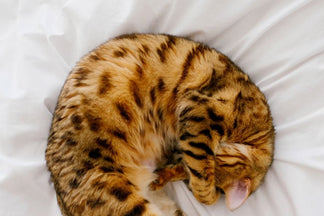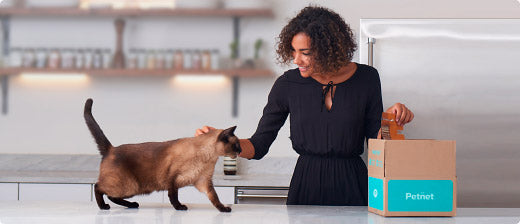Obesity statistics in the U.S. have been climbing for decades. According to the CDC more than one-third of American adults are obese (35.7%). The causes seem to lie not only with genetics, but also (and mostly with) changes in the way Americans live. There have been many changes in the pace of life and quality of food that people eat. People don’t get as much physical activity in their regular everyday activities and so much time is spent working that good meals cooked from scratch are hard to come by.
…And How Does This Apply to Fluffy?
With all of these changes causing such an epidemic of obesity in humans, no one should be surprised that the statistics for obesity in cats (who depend on us for everything) are also rising. According the Association for Pet Obesity Prevention (APOP), 57.6% of American pet cats are either overweight or obese. Just like us humans, cats are at higher risk for a lot of devastating diseases when they become obese; type 2 Diabetes (obese cats are 3X more likely to get this), Arthritis, heart and respiratory diseases, high blood pressure, certain cancers, and Hepatic Lipidosis.
There is one other technical difficulty obese cats face – grooming. At some point it will become difficult for the cat to groom its genital area and potentially areas around the neck and chin. Just imagine what it must feel like for a cat that can not remove feces or urine from its own body! Surely rashes, sores, and bad odors would begin to develop.
Is My Cat Fat?
It is always best to get a proper evaluation done by a veterinarian if you have concerns about your cat’s weight. One check that you can do on your own is to gently rub your hands along your cat’s body while the cat is standing up. If the cat is the ideal weight, you will be able to feel the ribs with a small layer of fat over them. If you have to press to feel the cat’s ribs, the cat is likely overweight. If the cat feels bony, it is likely underweight – there should be some fat.
Another way to evaluate is to look at the cat by looking at it from the top and then from the side. Your veterinarian will probably use a method like this (or a combination of methods) to give your cat a number on a scale from 1 -9 (where 1 is very underweight, 5 is ideal weight, and 9 is very obese). When looking from the top, the ideal weight cat will have a defined “waist” below its ribs. Looking from the side, a cat of the ideal weight would have a raised abdomen. There should be no jiggling fat when the cat walks. However, some cats have extra skin that hangs down and is not fatty, don’t worry about this extra skin.
Battling the Bulge
Don’t put your cat on a diet until you talk to your veterinarian. It is really important that you rule out any thyroid problems or other disorders that could be adding to the weight gain. If it is determined that the cat is healthy other than the obesity, then you and your veterinarian can tailor a diet and exercise plan to suit your cat’s needs. Cats need to lose weight very slowly or they could develop Hepatic Lipidosis (fatty liver disease). Don’t be discouraged when the veterinarian’s plan will take 6 – 8 months to get your cat to his/her ideal weight. A healthy weight-loss goal for cats is 1 pound per month.
Simply feeding your cat less of the food it is currently eating may not be the answer to your cat’s weight problem. The cat’s new diet should be keeping all of the nutrients the cat needs to survive, while discarding the ingredients that are just adding to the fat deposits without any benefit to the cat. Your current food may not be providing the correct proportion of nutrients for your cat , causing your cat to compensate by overeating. Getting the results you want may require switching to a more nutrient rich food (higher protein, lower carbohydrates). You may also have to stop free-feeding and feed small, frequent, scheduled meals throughout the day.
Don’t forget the importance of physical activity. Obese cats are often very lazy. Engaging your cat in vigorous play for 20 minutes per day could help tremendously (you do not need to do all 20 minutes at once). Exercise will increase your cat’s metabolic rate, burn calories, reduce appetite, and even help to change the composition of your cat’s body.
Tips & Tricks
It will take some real commitment to help an obese cat lose weight. Stay strong and don’t give in to those pitiful “feed me even though it isn’t time yet” faces and you will be doing your cat a world of good. Here are some tips to help you through.
- Affection & Attention: Use affection and attention rather than treats to reward your cat. Treats are often empty calories. Cats love attention and affection too!
- Good Treats: When you feel that treats are a necessity, give small pieces of cooked chicken or fish rather than store bought treats. The chicken or fish will have nutrients that the cat needs without the empty calories.
- Avoid Human Food: Close the cat in another room when people are eating so that it will not get a hold of any human food.
- Play! Play! Play! Take the time to pull out “the red dot” or a feather toy for the cat to bat at and chase. This exercise will do wonders for the cat in its weight loss journey. It will also be good for the cat’s brain and emotional state.
- Playmate: Consider getting a second cat if you only have one. Giving your cat a playmate will help it to get some much needed exercise (and maybe a little social grooming now and then).
- Count Calories: Rather than feeding your cat with the recommended feeding sizes on the bag, box, or can, count calories. The recommended feeding portions are often too large.
- Improve Taste of Healthy Food: Make diet food a little more appetizing by adding a little taste of salmon juice or Omega-3 fatty acid. Warming the food may help as well.
- “Find the Food Dish”: Move the food dish away from the cat’s favorite sleeping areas. This will require the cat to walk a little further (and thus get exercise) to get to the dish. Of course, you have a smart kitty and he/she will catch on and start sleeping near the dish again. This means you may have to play “find the food dish” and move the dish around the house frequently.
- Adjust: Weigh the cat every month and adjust your plan as necessary with your veterinarian.
- Don’t give up and don’t give in! Your cat may do all kinds of crazy things to try and get you to feed him/her like he/she is used to being fed. Change is tough on cats, but it will be worth it to see your cat lose the weight and be healthier. Giving in might please them for the moment, but it may cause great pain in the long run.
About the Author: Robin Mudge is the Detroit based blogger behind Playful Kitty. Animals are one of her greatest passions. Besides spending lots of time with her 2 cats (Cinco and Manna), Robin loves to learn and enjoys expressing herself artistically.


 Health and Fitness
Health and Fitness
 Health and Fitness
Health and Fitness
 Health and Fitness
Health and Fitness
